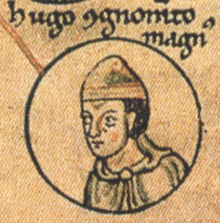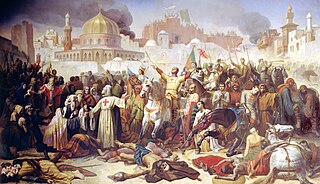Related Research Articles

The First Crusade (1096–1099) was the first of a series of religious wars, or Crusades, initiated, supported and at times directed by the Latin Church in the medieval period. The objective was the recovery of the Holy Land from Islamic rule. While Jerusalem had been under Muslim rule for hundreds of years, by the 11th century the Seljuk takeover of the region threatened local Christian populations, pilgrimages from the West, and the Byzantine Empire itself. The earliest initiative for the First Crusade began in 1095 when Byzantine emperor Alexios I Komnenos requested military support from the Council of Piacenza in the empire's conflict with the Seljuk-led Turks. This was followed later in the year by the Council of Clermont, during which Pope Urban II supported the Byzantine request for military assistance and also urged faithful Christians to undertake an armed pilgrimage to Jerusalem.
Guibert de Nogent was a Benedictine historian, theologian, and author of autobiographical memoirs. Guibert was relatively unknown in his own time, going virtually unmentioned by his contemporaries. He has only recently caught the attention of scholars who have been more interested in his extensive autobiographical memoirs and personality which provide insight into medieval life.

The Council of Clermont was a mixed synod of ecclesiastics and laymen of the Catholic Church, called by Pope Urban II and held from 17 to 27 November 1095 at Clermont, Auvergne, at the time part of the Duchy of Aquitaine.

Hugh, called the Great was the first count of Vermandois from the House of Capet. He is known primarily for being one of the leaders of the First Crusade. His nickname Magnus is probably a bad translation into medieval Latin of an Old French nickname, le Maisné, meaning "the younger", referring to Hugh as younger brother of King Philip I of France.
Fulcher of Chartres was a priest who participated in the First Crusade. He served Baldwin I of Jerusalem for many years and wrote a Latin chronicle of the Crusade.

The siege of Jerusalem during the First Crusade lasted for one month and eight days, from 7 June 1099 to 15 July 1099. It was carried out by the Crusader army, which successfully captured Jerusalem from the Fatimid Caliphate and subsequently founded the Kingdom of Jerusalem. Having returned the city and the Church of the Holy Sepulchre to Christian rule, the siege was the final major armed engagement of the First Crusade, which had been proclaimed in 1095 to recover the Holy Land for the Christians in the context of the Muslim conquest. A number of eyewitness accounts of the battle were recorded, with the most quoted events being derived from the anonymous Latin-language chronicle Gesta Francorum.
Tatikios or Taticius was an Eastern Roman general of Turkish origin during the reign of Alexius I Comnenus. His name is also rendered as Tetigus, Tatizius, Tatitius, Tatic, or Tetig.
The Gesta Francorum, or Gesta Francorum et aliorum Hierosolimitanorum, is a Latin chronicle of the First Crusade by an anonymous author connected with Bohemond of Taranto.

Deus vult is a Christian motto relating to Divine providence. It was first chanted by Catholics during the First Crusade in 1096 as a rallying cry, most likely under the form Deus le veult or Deus lo vult, as reported by the Gesta Francorum and the Historia Belli Sacri.

Maarat al-Numan, also known as al-Ma'arra, is a city in northwestern Syria, 33 km (21 mi) south of Idlib and 57 km (35 mi) north of Hama, with a population of about 58,008 before the Civil War. In 2017, it was estimated to have a population of 80,000, including several displaced by fighting in neighbouring towns. It is located on the highway between Aleppo and Hama and near the Dead Cities of Bara and Serjilla.
Gesta may refer to:

The siege of Ma'arra occurred in late 1098 in the city of Ma'arrat Nu'man, in what is modern-day Syria, during the First Crusade. It is infamous for the claims of widespread cannibalism committed by the crusaders.
William the Carpenter, viscount of Melun, was a French nobleman who participated in the Reconquista in Spain and on the First Crusade. He was notorious for defecting from the army both in Spain and on the crusade, but he was also known for his strength in battle, whence he earned his nickname "the Carpenter." He returned to the Holy Land after the crusade, and nothing further is known of his life or death.

The historiography of the Crusades is the study of history-writing and the written history, especially as an academic discipline, regarding the military expeditions initially undertaken by European Christians in the 11th, 12th, or 13th centuries to the Holy Land. This scope was later extended to include other campaigns initiated, supported, and sometimes directed by the Roman Catholic Church. The subject has involved competing and evolving interpretations since the capture of Jerusalem in 1099 until the present day. The religious idealism, use of martial force and pragmatic compromises made by those involved in crusading were controversial, both at the time and subsequently. Crusading was integral to Western European culture, with the ideas that shaped behaviour in the Late Middle Ages retaining currency beyond the 15th century in attitude rather than action.
Jay Rubenstein is an American historian of the Middle Ages.
Bartolf of Nangis is the conventional name given to the author of the Gesta Francorum Iherusalem expugnantium, a history of the First Crusade.
The Historia Francorum qui ceperunt Iherusalem, which has also been published under the simple title Liber ("Book"), is a Latin chronicle of the First Crusade written between 1098 and 1105, probably completed by 1101, by Pons of Balazun and Raymond of Aguilers.
The Historia belli sacri, also called the Historia de via Hierosolymis or Historia peregrinorum, is a chronicle of the First Crusade and the early years of the Crusader states written by an anonymous monk of the Abbey of Montecassino. It covers the years 1095–1131 and must have been mostly compiled around 1130. It is sometimes called the "Monte Cassino Chronicle" for simplicity.
Raymond Pilet (1075–1120), the only child of Bernard I Pilet of Narbonne and his wife, whose name is unknown. Seigneur of Alès. Bernard was the son of Raymond II, Viscount of Narbone from 1066 to 1067. The name “pilet” refers to a fur that the nobility wore over their cuirass and coats-of-arms. Raymond distinguished himself as a combatant during the First Crusade.

The Gesta Francorum Iherusalem peregrinantium is a Latin chronicle of the First Crusade written on 1101, 1106, 1124 until 1127 by Fulcher of Chartres. He was a priest who participated in the First Crusade. He served Baldwin I of Jerusalem for many years, and wrote a chronicle of the Crusade, writing in Latin.
References
- The Deeds of God through the Franks, e-text from Project Gutenberg. Translated by Robert Levine 1997.
- Robert Levine (1997). The Deeds of God through the Franks : A Translation of Guibert de Nogent's 'Gesta Dei per Francos' . ISBN 0-85115-693-2
- Jay Rubenstein (2002). Guibert of Nogent: Portrait of a Medieval Mind. ISBN 0-415-93970-4
- Herbermann, Charles, ed. (1913). . Catholic Encyclopedia . New York: Robert Appleton Company.
Specific
- ↑ Lapina, Elizabeth (2009). "Anti-Jewish rhetoric in Guibert of Nogent's Dei gesta per Francos". Journal of Medieval History. 35 (3): 239–253. doi:10.1016/j.jmedhist.2009.05.002. S2CID 159522147.
- ↑ Plumtree, James (2018). "Charlemagne's Road, God's Threshing Floor; Comprehending the Role of Hungary in the First Crusade". Hungarian Studies. 32: 1-26 (pp. 8-11). doi:10.1556/044.2018.32.1.1. S2CID 165886532.